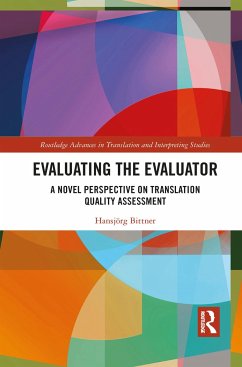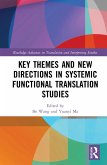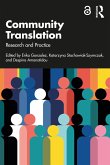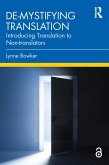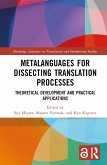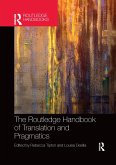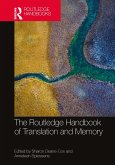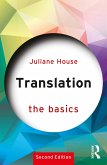- Broschiertes Buch
- Merkliste
- Auf die Merkliste
- Bewerten Bewerten
- Teilen
- Produkt teilen
- Produkterinnerung
- Produkterinnerung
This book offers a theoretical framework for assessing translation quality grounded in supportive argumentation. The volume outlines a systematic framework for translators and translation critics to substantiate their decisions and judgments on a translation's quality and in the case of negative criticism, put forward a more effective translation solution. The book traces the decision-making process underpinning translation practice, considering the different factors surrounding a particular translation to inform the most appropriate translation strategy, such as the temporal and geographical…mehr
Andere Kunden interessierten sich auch für
![Key Themes and New Directions in Systemic Functional Translation Studies Key Themes and New Directions in Systemic Functional Translation Studies]() Key Themes and New Directions in Systemic Functional Translation Studies138,99 €
Key Themes and New Directions in Systemic Functional Translation Studies138,99 €![Community Translation Community Translation]() Community Translation40,99 €
Community Translation40,99 €![De-mystifying Translation De-mystifying Translation]() Lynne BowkerDe-mystifying Translation38,99 €
Lynne BowkerDe-mystifying Translation38,99 €![Metalanguages for Dissecting Translation Processes Metalanguages for Dissecting Translation Processes]() Metalanguages for Dissecting Translation Processes154,99 €
Metalanguages for Dissecting Translation Processes154,99 €![The Routledge Handbook of Translation and Pragmatics The Routledge Handbook of Translation and Pragmatics]() The Routledge Handbook of Translation and Pragmatics50,99 €
The Routledge Handbook of Translation and Pragmatics50,99 €![The Routledge Handbook of Translation and Memory The Routledge Handbook of Translation and Memory]() The Routledge Handbook of Translation and Memory246,99 €
The Routledge Handbook of Translation and Memory246,99 €![Translation Translation]() Juliane HouseTranslation22,99 €
Juliane HouseTranslation22,99 €-
-
-
This book offers a theoretical framework for assessing translation quality grounded in supportive argumentation. The volume outlines a systematic framework for translators and translation critics to substantiate their decisions and judgments on a translation's quality and in the case of negative criticism, put forward a more effective translation solution. The book traces the decision-making process underpinning translation practice, considering the different factors surrounding a particular translation to inform the most appropriate translation strategy, such as the temporal and geographical relationship between source and target texts, special provisions required by clients, timeframe, qualifications, and sociocultural and political issues. The framework posits that such factors should underpin any arguments used by the translator in adopting a given strategy and in turn, that any criticism of a translation's quality must be in line with the same argumentative structure. Applied to a corpus of translation examiners' reports of translation, the book demonstrates how this framework can act as a tool to be scaled to fit the needs of the different actors of a translation - translators, critics, and scholars. This book will be of interest to scholars in translation studies and practicing translators.
Produktdetails
- Produktdetails
- Routledge Advances in Translation and Interpreting Studies
- Verlag: Routledge / Taylor & Francis
- Seitenzahl: 298
- Erscheinungstermin: 2. August 2021
- Englisch
- Abmessung: 229mm x 152mm x 16mm
- Gewicht: 412g
- ISBN-13: 9781032083087
- ISBN-10: 1032083085
- Artikelnr.: 62149424
- Herstellerkennzeichnung
- Libri GmbH
- Europaallee 1
- 36244 Bad Hersfeld
- gpsr@libri.de
- Routledge Advances in Translation and Interpreting Studies
- Verlag: Routledge / Taylor & Francis
- Seitenzahl: 298
- Erscheinungstermin: 2. August 2021
- Englisch
- Abmessung: 229mm x 152mm x 16mm
- Gewicht: 412g
- ISBN-13: 9781032083087
- ISBN-10: 1032083085
- Artikelnr.: 62149424
- Herstellerkennzeichnung
- Libri GmbH
- Europaallee 1
- 36244 Bad Hersfeld
- gpsr@libri.de
Hansjörg Bittner served as a lecturer at Eastern Mediterranean University (English Literature) and at the University of Hildesheim (Translation Studies). His publications cover poetics, translation theory, and audiovisual translation. A practising translator, he is currently a lecturer at Hof University of Applied Sciences, teaching business English and technical English.
IntroductionThe quality of translation: different approachesJuliane HouseMalcolm WilliamsHeidrun Gerzymisch-Arbogast and Klaus MudersbachErnst-August GuttOther approaches to translation qualityApproaches to translation quality in the twentieth centuryApproaches to translation quality in the twenty-first centuryPreliminary assumptionsDefining translation quality and translation quality assessmentSome thoughts on measuring qualitySome thoughts on achieving good qualityRevisiting overt and covert translationRefining the concept of overt/covert translation: overviewRefining the concept of overt/covert translation: detailed discussionThe problem of subjective evaluationThe problem of subjectivity from a philosophical point of viewThe process of translation quality assessmentThe problem of subjectivity from a translation studies point of viewHow to curb the subjective in translation quality assessmentTowards evaluating the evaluatorSome views on how to evaluate translationsThe evaluation of commented translationsQuality factors of translationThe translator's daffodilUnderlying assumptionsFactor categoriesSource textLanguage pairs in translation and source text analysis (Nord)Sender and sender's intentionAudience and mediumPlace and time of communicationMotive for communication and text functionSource text defectsSummary of source text factorsText formIntratextual factorsSubject matter and contentText composition and non-verbal elementsLexis, syn
Contents
Introduction
The quality of translation: different approaches
Juliane House
Malcolm Williams
Heidrun Gerzymisch-Arbogast and Klaus Mudersbach
Ernst-August Gutt
Other approaches to translation quality
Approaches to translation quality in the twentieth century
Approaches to translation quality in the twenty-first century
Preliminary assumptions
Defining translation quality and translation quality assessment
Some thoughts on measuring quality
Some thoughts on achieving good quality
Revisiting overt and covert translation
Refining the concept of overt/covert translation: overview
Refining the concept of overt/covert translation: detailed discussion
The problem of subjective evaluation
The problem of subjectivity from a philosophical point of view
The process of translation quality assessment
The problem of subjectivity from a translation studies point of view
How to curb the subjective in translation quality assessment
Towards evaluating the evaluator
Some views on how to evaluate translations
The evaluation of commented translations
Quality factors of translation
The "translator's daffodil"
Underlying assumptions
Factor categories
Source text
Language pairs in translation and source text analysis (Nord)
Sender and sender's intention
Audience and medium
Place and time of communication
Motive for communication and text function
Source text defects
Summary of source text factors
Text form
Intratextual factors
Subject matter and content
Text composition and non-verbal elements
Lexis, syntax, and suprasegmental features
Selected text types
Poetry, drama, and comics
Audiovisual translation
Summary of text form factors
Client
Client roles
Deadlines
Glossaries
Stipulations and specifications
Motivation
Summary of client factors
Translator
Overview and translation tools
Translation competence
Qualification and motivation
Summary of translator factors
Culture
The relativity of culture
Cultural norms
Translation in different cultures at different times in history
Borderline cases: unlikely successes and EU translations
Summary of culture factors
Politics
Power relations
Censorship
More power issues
Politics and the evaluation of translation quality
Summary of politics factors
The principle of argumentation
The need for an argumentative translation quality assessment
The need for translation theory
The need for argumentation in translation
Summary - the need for an argumentative translation quality assessment
Translation decisions
Decision-making and translation
Defining the translation strategy
Summary of the decision-making process in translation
The argumentation process
A theory of dialectical structures
Dialectical structures in translation quality assessment
Examples of argumentation
Criticising the translation of a young adult novel
Criticising the translation of a survey
Evaluating the evaluator
The corpus: examiners' reports of commented translations
Methodology
Looking at formal characteristics
Looking at aspects of translation quality assessment
Source and target
Errors and achievements
Evidence and arguments
Summary of methodological issues
Results
Formal characteristics
Aspects of translation quality assessment
Source and target
Errors and achievements
Evidence and arguments
Summary of results
Conclusion
Introduction
The quality of translation: different approaches
Juliane House
Malcolm Williams
Heidrun Gerzymisch-Arbogast and Klaus Mudersbach
Ernst-August Gutt
Other approaches to translation quality
Approaches to translation quality in the twentieth century
Approaches to translation quality in the twenty-first century
Preliminary assumptions
Defining translation quality and translation quality assessment
Some thoughts on measuring quality
Some thoughts on achieving good quality
Revisiting overt and covert translation
Refining the concept of overt/covert translation: overview
Refining the concept of overt/covert translation: detailed discussion
The problem of subjective evaluation
The problem of subjectivity from a philosophical point of view
The process of translation quality assessment
The problem of subjectivity from a translation studies point of view
How to curb the subjective in translation quality assessment
Towards evaluating the evaluator
Some views on how to evaluate translations
The evaluation of commented translations
Quality factors of translation
The "translator's daffodil"
Underlying assumptions
Factor categories
Source text
Language pairs in translation and source text analysis (Nord)
Sender and sender's intention
Audience and medium
Place and time of communication
Motive for communication and text function
Source text defects
Summary of source text factors
Text form
Intratextual factors
Subject matter and content
Text composition and non-verbal elements
Lexis, syntax, and suprasegmental features
Selected text types
Poetry, drama, and comics
Audiovisual translation
Summary of text form factors
Client
Client roles
Deadlines
Glossaries
Stipulations and specifications
Motivation
Summary of client factors
Translator
Overview and translation tools
Translation competence
Qualification and motivation
Summary of translator factors
Culture
The relativity of culture
Cultural norms
Translation in different cultures at different times in history
Borderline cases: unlikely successes and EU translations
Summary of culture factors
Politics
Power relations
Censorship
More power issues
Politics and the evaluation of translation quality
Summary of politics factors
The principle of argumentation
The need for an argumentative translation quality assessment
The need for translation theory
The need for argumentation in translation
Summary - the need for an argumentative translation quality assessment
Translation decisions
Decision-making and translation
Defining the translation strategy
Summary of the decision-making process in translation
The argumentation process
A theory of dialectical structures
Dialectical structures in translation quality assessment
Examples of argumentation
Criticising the translation of a young adult novel
Criticising the translation of a survey
Evaluating the evaluator
The corpus: examiners' reports of commented translations
Methodology
Looking at formal characteristics
Looking at aspects of translation quality assessment
Source and target
Errors and achievements
Evidence and arguments
Summary of methodological issues
Results
Formal characteristics
Aspects of translation quality assessment
Source and target
Errors and achievements
Evidence and arguments
Summary of results
Conclusion
IntroductionThe quality of translation: different approachesJuliane HouseMalcolm WilliamsHeidrun Gerzymisch-Arbogast and Klaus MudersbachErnst-August GuttOther approaches to translation qualityApproaches to translation quality in the twentieth centuryApproaches to translation quality in the twenty-first centuryPreliminary assumptionsDefining translation quality and translation quality assessmentSome thoughts on measuring qualitySome thoughts on achieving good qualityRevisiting overt and covert translationRefining the concept of overt/covert translation: overviewRefining the concept of overt/covert translation: detailed discussionThe problem of subjective evaluationThe problem of subjectivity from a philosophical point of viewThe process of translation quality assessmentThe problem of subjectivity from a translation studies point of viewHow to curb the subjective in translation quality assessmentTowards evaluating the evaluatorSome views on how to evaluate translationsThe evaluation of commented translationsQuality factors of translationThe translator's daffodilUnderlying assumptionsFactor categoriesSource textLanguage pairs in translation and source text analysis (Nord)Sender and sender's intentionAudience and mediumPlace and time of communicationMotive for communication and text functionSource text defectsSummary of source text factorsText formIntratextual factorsSubject matter and contentText composition and non-verbal elementsLexis, syn
Contents
Introduction
The quality of translation: different approaches
Juliane House
Malcolm Williams
Heidrun Gerzymisch-Arbogast and Klaus Mudersbach
Ernst-August Gutt
Other approaches to translation quality
Approaches to translation quality in the twentieth century
Approaches to translation quality in the twenty-first century
Preliminary assumptions
Defining translation quality and translation quality assessment
Some thoughts on measuring quality
Some thoughts on achieving good quality
Revisiting overt and covert translation
Refining the concept of overt/covert translation: overview
Refining the concept of overt/covert translation: detailed discussion
The problem of subjective evaluation
The problem of subjectivity from a philosophical point of view
The process of translation quality assessment
The problem of subjectivity from a translation studies point of view
How to curb the subjective in translation quality assessment
Towards evaluating the evaluator
Some views on how to evaluate translations
The evaluation of commented translations
Quality factors of translation
The "translator's daffodil"
Underlying assumptions
Factor categories
Source text
Language pairs in translation and source text analysis (Nord)
Sender and sender's intention
Audience and medium
Place and time of communication
Motive for communication and text function
Source text defects
Summary of source text factors
Text form
Intratextual factors
Subject matter and content
Text composition and non-verbal elements
Lexis, syntax, and suprasegmental features
Selected text types
Poetry, drama, and comics
Audiovisual translation
Summary of text form factors
Client
Client roles
Deadlines
Glossaries
Stipulations and specifications
Motivation
Summary of client factors
Translator
Overview and translation tools
Translation competence
Qualification and motivation
Summary of translator factors
Culture
The relativity of culture
Cultural norms
Translation in different cultures at different times in history
Borderline cases: unlikely successes and EU translations
Summary of culture factors
Politics
Power relations
Censorship
More power issues
Politics and the evaluation of translation quality
Summary of politics factors
The principle of argumentation
The need for an argumentative translation quality assessment
The need for translation theory
The need for argumentation in translation
Summary - the need for an argumentative translation quality assessment
Translation decisions
Decision-making and translation
Defining the translation strategy
Summary of the decision-making process in translation
The argumentation process
A theory of dialectical structures
Dialectical structures in translation quality assessment
Examples of argumentation
Criticising the translation of a young adult novel
Criticising the translation of a survey
Evaluating the evaluator
The corpus: examiners' reports of commented translations
Methodology
Looking at formal characteristics
Looking at aspects of translation quality assessment
Source and target
Errors and achievements
Evidence and arguments
Summary of methodological issues
Results
Formal characteristics
Aspects of translation quality assessment
Source and target
Errors and achievements
Evidence and arguments
Summary of results
Conclusion
Introduction
The quality of translation: different approaches
Juliane House
Malcolm Williams
Heidrun Gerzymisch-Arbogast and Klaus Mudersbach
Ernst-August Gutt
Other approaches to translation quality
Approaches to translation quality in the twentieth century
Approaches to translation quality in the twenty-first century
Preliminary assumptions
Defining translation quality and translation quality assessment
Some thoughts on measuring quality
Some thoughts on achieving good quality
Revisiting overt and covert translation
Refining the concept of overt/covert translation: overview
Refining the concept of overt/covert translation: detailed discussion
The problem of subjective evaluation
The problem of subjectivity from a philosophical point of view
The process of translation quality assessment
The problem of subjectivity from a translation studies point of view
How to curb the subjective in translation quality assessment
Towards evaluating the evaluator
Some views on how to evaluate translations
The evaluation of commented translations
Quality factors of translation
The "translator's daffodil"
Underlying assumptions
Factor categories
Source text
Language pairs in translation and source text analysis (Nord)
Sender and sender's intention
Audience and medium
Place and time of communication
Motive for communication and text function
Source text defects
Summary of source text factors
Text form
Intratextual factors
Subject matter and content
Text composition and non-verbal elements
Lexis, syntax, and suprasegmental features
Selected text types
Poetry, drama, and comics
Audiovisual translation
Summary of text form factors
Client
Client roles
Deadlines
Glossaries
Stipulations and specifications
Motivation
Summary of client factors
Translator
Overview and translation tools
Translation competence
Qualification and motivation
Summary of translator factors
Culture
The relativity of culture
Cultural norms
Translation in different cultures at different times in history
Borderline cases: unlikely successes and EU translations
Summary of culture factors
Politics
Power relations
Censorship
More power issues
Politics and the evaluation of translation quality
Summary of politics factors
The principle of argumentation
The need for an argumentative translation quality assessment
The need for translation theory
The need for argumentation in translation
Summary - the need for an argumentative translation quality assessment
Translation decisions
Decision-making and translation
Defining the translation strategy
Summary of the decision-making process in translation
The argumentation process
A theory of dialectical structures
Dialectical structures in translation quality assessment
Examples of argumentation
Criticising the translation of a young adult novel
Criticising the translation of a survey
Evaluating the evaluator
The corpus: examiners' reports of commented translations
Methodology
Looking at formal characteristics
Looking at aspects of translation quality assessment
Source and target
Errors and achievements
Evidence and arguments
Summary of methodological issues
Results
Formal characteristics
Aspects of translation quality assessment
Source and target
Errors and achievements
Evidence and arguments
Summary of results
Conclusion

